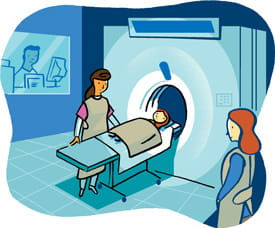You may want to practice lying still with your child for periods of 5 to 10 minutes at a time prior to your child’s scheduled scan. This practice may help prevent your child from needing sedation medication.
You may want to bring along a “comfort” item—such as a favorite stuffed animal or “blankie”—for your child to hold during the scan. You may also bring your child’s favorite movie or DVD to watch during the exam.
Depending on what part of your child’s body is being scanned, there may be important instructions on things to do or not do the day before and the day of your child’s CT. Please follow the specific instructions given to you by your doctor before the scan. Items such as jewelry, zippers, specific clothing items or glitter could interfere with the diagnostic exam and may need to be removed before imaging.
Your child’s doctor may order sedation medication for your child, but it may not be needed. The Department of Pediatric Radiology staff will make every effort to relax your child with music therapy, room decorations, and visual distraction during the scan, which can shorten your child's scan time and make sedation unnecessary.









 At
At